Cecco Bravo and a 17th-century subsoil beauty
Cecco Bravo is dramatic and mysterious, feeding on hallucinatory eccentricity to make the viewer feeling part of the scene.
The birth of Cecco, son of Antonio di Giovanni and Polita di Domenico Baggiani, who lived in the community of Sant’Ambrogio, fell on November 15, 1601. As noted by Anna Barsanti, the family already had a first daughter, Maria, born on October 15, 1598, who was followed by Elisabetta, who was born on August 1, 1606. The latter always took care of her brother and left heir, upon her death in 1683, the company of St. Joseph known as the Legnaioli, among whose papers, preserved in the State Archives of Florence, Barsanti herself has unearthed the precious Montelatici archive.
From these documents we learn that Cecco’s family had settled since the fifteenth century in the Montelatico quarter, just outside Florence, in the low plain to the east beyond Porta alla Croce, which gave its name to many families in the area, including that of Cecco. The Montelatici were a farming family, devoted mainly to vegetable and fruit farming. Antonio di Giovanni soon left his family unit since, in 1606, when his daughter Elisabetta was baptized, he was already reported to be living in the community of Sant’Ambrogio where he was working as a “battilano.”
Neither the papers of the Montelatici household nor other archival sources reveal why Cecco decided to become an artist. A Medici document and biographers disclose, however, who his first master was: Giovanni Bilivert, a painter much loved by the Medici court which had granted him as a studio some rooms in the Uffizi and a monthly commission of fifteen scudi.
Filippo Baldinucci, followed by all other biographers, is the first to mention Cecco as a pupil of Bilivert, whose workshop was a privileged environment to admire ancient paintings and statues and to meet foreign artists, such as the Lorraine-born Jacques Callot, who, from 1614, shared Bilivert’s atelier. This lively artistic environment disintegrated when, after the death of Grand Duke Cosimo II de’ Medici in 1621, the regent grand duchesses Cristina, Cosimo’s mother, and Maria Maddalena, sister of Emperor Ferdinand and Cosimo’s widow, imposed a regime of strict austerity. Bilivert, outraged at having lost his commission, abandoned the premises-although the court did not revoke it-followed probably by Cecco, who sought protection with Matteo Rosselli, the leader of the school to whom were entrusted, between 1621 and 1623, the large fresco decorations of the Casino Mediceo di San Marco, desired by Cardinal Carlo, and those of the villa at Poggio Imperiale, requested by Maria Maddalena of Austria.
While Cecco’s presence in the building site of the Casino Mediceo is still sub iudice, his hand in the villa at Poggio Imperiale has long since been independently recognized, by Barsanti and Pagliarulo, in the lunette with The Prophetess Mary praises the Lord after passing through the Red Sea in the Room of the Biblical Heroines. In the rich marbling of the robes and the noble Greek-style profiles of the protagonists, the Bilivertian lesson is evident, while the narrative tone seems rather in line with Rossellian teachings.
Montelatici’s public debut, the altarpiece depicting St. Nicholas of Bari freeing three young men unjustly condemned to death, painted in 1625 for Archdeacon Pietro Niccolini, intended for the family altar in the church of San Simone in Florence and now in a private collection, reiterates in its chromatic sumptuousness the importance of Bilivertian discipline. The orangey red of the manigoldo’s vest, the pink robe and the blue of the condemned man’s mantle in front of St. Nicholas, the warm gold and silky burgundy of the saint’s cope, and the dark green of the drape in the lower right corner are the most precious notes of the canvas, which already attests to Montelatici’s typical eagerness in the gesture of the disheveled-headed henchman and in the awkward pose of the young man in the foreground, for which the lesson of Rosso Fiorentino appears decisive.
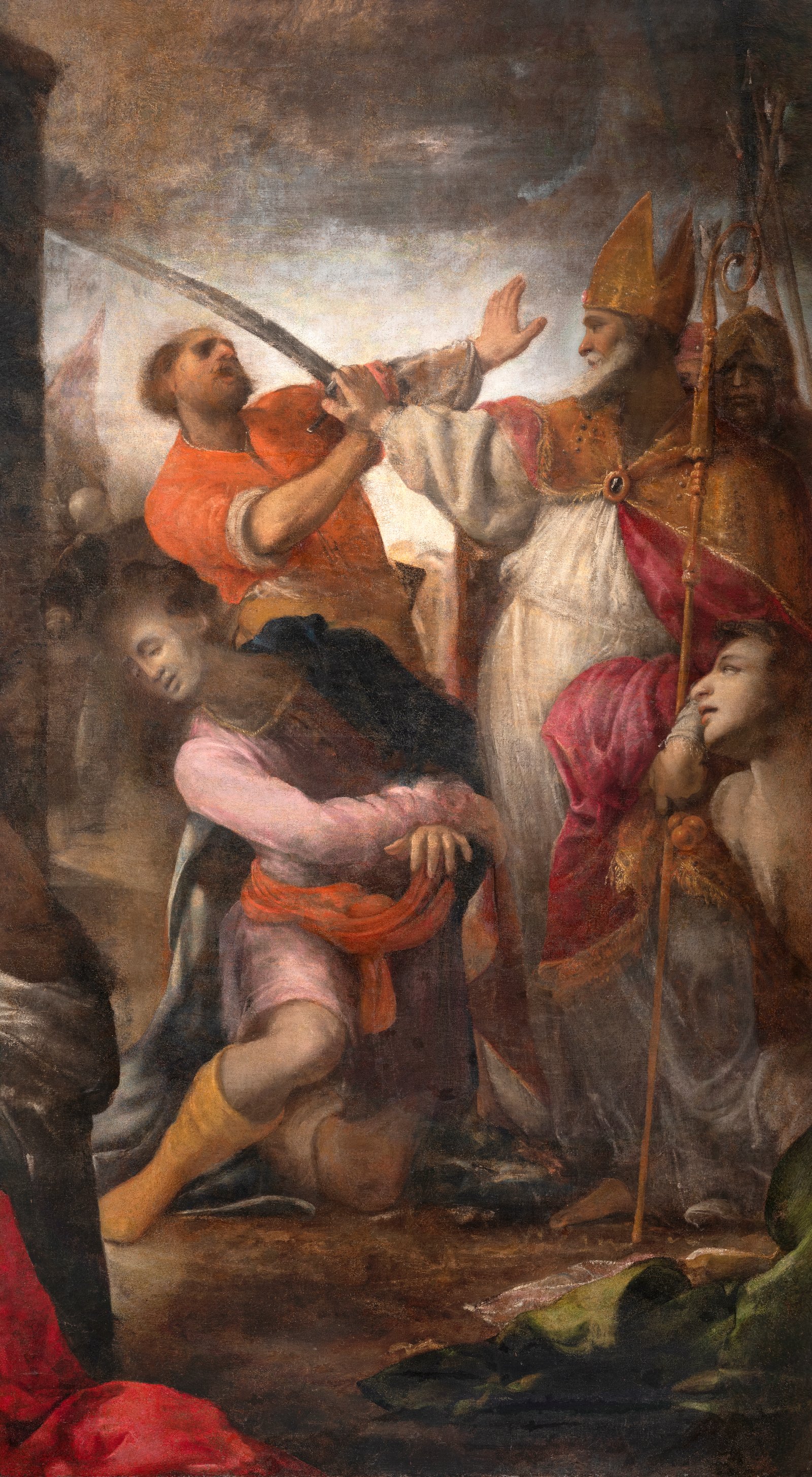
Cecco’s official career began on June 29, 1629, the year he paid the registration fee at the Accademia Fiorentina del Disegno.
By early January 1630, Nostro was already reported to own a workshop in Porta Rossa, frequented by several pupils who made copies of his paintings. In this year is dated the Semiramide now in the municipal collections of Prato, the subject of a dispute between Cecco and the knight Lorenzo dal Borgo that was to be resolved in favor of the painter.
If Bilivert’s sumptuous style is present in all the paintings that can be traced to this period, the coeval fresco painting is qualified by other and more significant experiences for the pursuit of his activity.
Evidence of the close relationship between the painter and the Servite order can be found in the six lunettes with episodes from the life of Bonaventura Bonaccorsi, frescoed in 1633 in the cloister of Santissima Annunziata in Pistoia, the city where Montelatici most likely moved to escape the terrible plague that struck Florence in 1630. Following the program of Father Arcangelo Giani, an authoritative chronicler of the order, Cecco tells the story of the blessed of Pistoria by evoking the disputes and duels between the opposing city factions, the preaching of Filippo Benizzi, Bonaventura’s conversion, his appeasement with his enemies, his decision to wear the habit of the servants of Mary and his penance to atone for his sins. The six lunettes, financed by the Pistoia families of the Bonaccorsi, the Gatteschi, and the Panciatichi, have a fast-paced rhythm, show amplified gestures, and their dress is picturesque and extravagant. Cecco continues the narrative line of Bernardino Poccetti, who had begun the cycle in 1601, reinterpreting it with a more agile and snappy spirit in line with that of Giovanni da San Giovanni, a colleague whom Our Lord had undoubtedly seen at work in the Florentine cloister of Ognissanti (c. 1619) and who was active in Pistoia at the same time in the little chapel of Palazzo Rospigliosi frescoing the delightful Stories of St. Catherine of Alexandria.
A strong sense of caricature also characterizes the fresco decoration of the study of Casa Buonarroti completed in 1636 for Michelangelo Buonarroti the Younger (Florence, 1568-1647), a poet and popular playwright at the Medici court who had devoted much energy to the realization of the program, as attested by the long lists of names and quick sketches of the characters shown in his papers. The latter showed attention to Florentine painters of at least two generations, whom he employed from the first half of the second decade for the decoration of the mansion on Via Ghibellina, and thus also resorted to Our. The small room painted by Cecco, the last of the mansion’s four boardrooms, has as its theme the celebration of Florence’s cultural primacy through the men who made it famous in the fields of letters, science and law.
The frescoes by Our are those on the ceiling depicting Wisdom surrounded by winged putti, those on the north wall where, against the background of Parnassus, Poets and Writers are depicted, and those on the west wall where Astronomers, Mathematicians and Navigators feature. The playful and extravagant putti surrounding Wisdom, caught in daring poses, and the spirited and snappy grisailles painted on a Pompeian yellow and red background confirm, if there was still a need, the whimsical and bizarre character of Cecco’s early days. In the gallery of Poets and Writers the most celebrated figures are presented: in the vestibule Monsignor Della Casa in ecclesiastical garb, behind him Guido Cavalcanti girded with laurels and, a little further on, Francesco Petrarch with laurel pointing to Plato’s carved head.
It was probably the overly mocking tone of the illustrious men, crowding confusedly from the parapet, of the other wall that annoyed Michelangelo Buonarroti the Younger, who fired Cecco to replace him with Domenico Pugliani and Matteo Rosselli. Galileo, depicted without any sign of reverence with a mocking grin, the nearby Amerigo Vespucci, ridiculously characterized by his enormous nose, and Guido Bonatti, with his gaze lost to the sky, are clear evidence of Cecco’s witty interpretation of the famous characters and his heightened interest, at this time, in the grotesque, the enormous and the caricatural. Not even the intervention of Bindaccio Ricasoli, brother of the canon Pandolfo mentioned above, succeeded in mending the relationship between the patron and the painter.
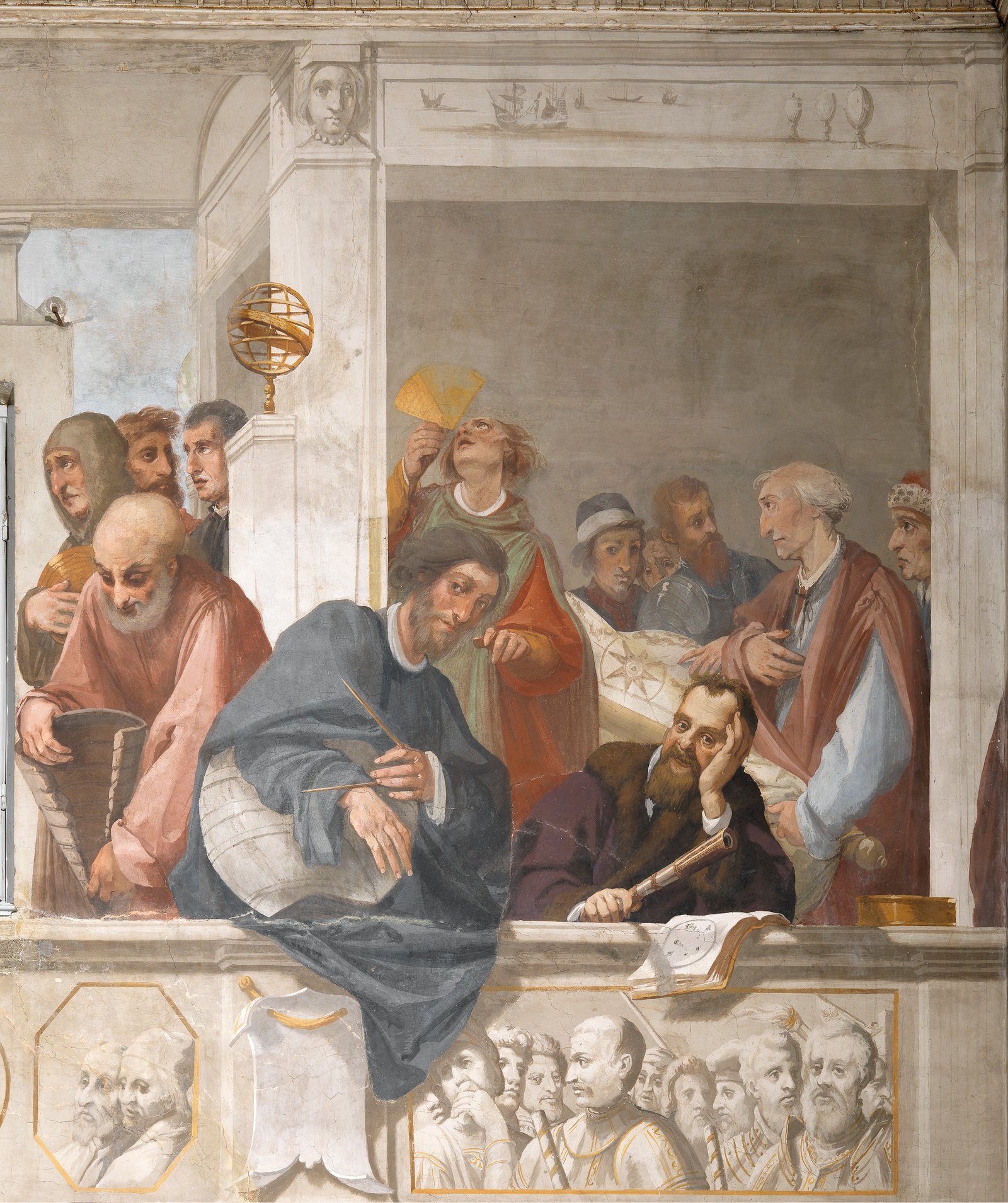
The fresco with St. Vitale and Sons, dating from 1636, in the new sacristy of the Madonna at the Santissima Annunziata in Florence, which had recently been built at the behest of Alessandro and Antonio Medici in memory of their father Vitale, an educated and wealthy Jew who converted to Christianity in the presence of Pope Gregory XIII and Cardinal Ferdinando de’ Medici. The faces of the patrons are concealed by Cecco in Saints Gervasius (Alexander, depicted as a neophyte awaiting baptism) and Protasius (Anthony, in ecstasy as he witnesses the miraculous vision of his father ascending to heaven). Here the grotesque tone of the characters is accentuated by the miraculous use of dazzling light, which spares neither the choir of angels at the top, nor the saints in the middle band, nor even the spirited little angel, which recalls the one frescoed by Cecco above the San Giovanni in the cloister of Sant’Antonino in San Marco.
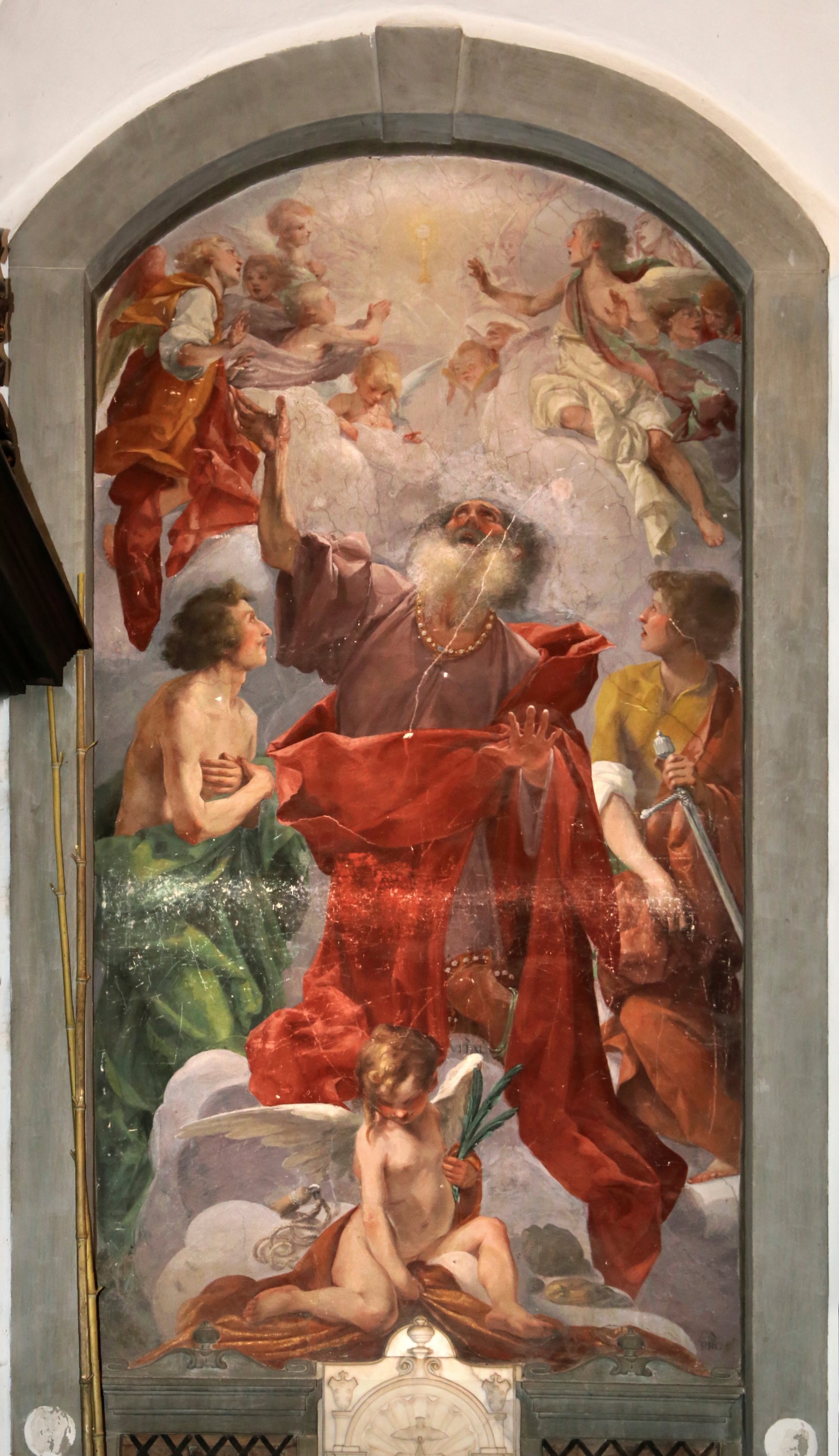
At the same time, Montelatici must also have been engaged in public assignments for private individuals, which are difficult to identify. It is indisputable, however, that the beautiful altarpiece with St. Michael the Archangel and Adoring Angels now in the parish church of Santa Maria dell’Antella, where a less expressive and more introverted language takes over, in consonance with that of Jacopo Vignali, belongs to this time, just past the middle of the fourth decade.
These are the years in which Cecco likely executed his landscape paintings, a rare genre in seventeenth-century Florentine painting before the Neapolitan Salvator Rosa arrived in the city in 1640 at the behest of Giovan Carlo de’ Medici. Many of Cecco’s known landscapes are done on copper or tablet. The choice of medium cannot have been accidental: I believe that, like the connoisseur he was, Cecco carefully chose the surfaces on which to trace his landscapes. A genre certainly less official and almost carried out in the intimacy of his own atelier to satisfy a personal pleasure, which required, however, great agility of hand and masterful tonal combinations.
Archival documents recall many of Montelatici’s landscapes, and the samples known today-about ten and all of high quality-confirm his use of the genre as early as the 1920s, as a document made public by Silvia Botticelli reveals that in January 1631 frames for “some villages” by Cecco Bravo were paid. The document is important because it attests to Montelatici’s relations with the wealthy banker Agnolo Galli (Florence, 1604-1657), the most prominent member of a family of humble origins from Prato who, having arrived in Florence in the last quarter of the sixteenth century, soon attained a respectable status in the city.
Between the fall of 1638 and the summer of the following year Cecco was actively working in the Salone degli Argenti in Palazzo Pitti, where he painted for Ferdinando II de’ Medici the two allegorical fresco lunettes with Lorenzo the Magnificent Welcomes the Muses and Lorenzo the Magnificent Bringer of Peace. After the death of Giovanni da San Giovanni in 1636, Ferdinando, who had recently been united in marriage to Vittoria della Rovere, wanted the most important painters of Florence at the time in the palace to complete the work. Along with Cecco, already employed at the time at the Hall of Porcelain, Ottavio Vannini and Francesco Furini answered the call. Distorting Mannozzi’s iconographic program, the triad, spokesmen for a new, exquisitely Florentine pictorial trend, in opposition to what Pietro da Cortona was producing in the same years at the Sala della Stufa, gave life to an allegorical cycle based on episodes from Lorenzo’s life reinterpreted in a modern key, fulfilling the work of Grand Duke Ferdinando, a worthy successor to the Magnifico and the new needle of the Italian political scales. In the lunettes by Our, the youthful grotesque vein seems to have been overcome, the color becomes more fluid and transparent, and the characters become more elegant no doubt thanks in part to the proximity of Francesco Furini, active on the opposite walls.
The adherence to Furinism soon wanes in Our, as evidenced by the ceiling fresco with St. Zanobi, St. Antonino and St. Charles Borromeo in the oratory of San Francesco dei Vanchetoni, completed on March 17, 1640, a polyphonic worksite in which the Paduan Pietro Liberi and the Tuscans Domenico Pugliani, Giovanni Martinelli and Lorenzo Lippi were also involved. Its distinguishing features are the accentuated scenic effect and the perspective layout of the figures. The saints are pictured in animated dispute, and the two disheveled angels holding pastorals, Saint Zanobi’s mitre, and Saint Charles Borromeo’s galero hover in excited flight. The textural softness, the evanescent colors ranging from gray to light blue to the lowered tones of red and yellow, and the accentuated foreshortening below up are elements previously unseen in Cecco’s painting production, which presuppose his travels to northern Italy: to Parma to admire Correggio and to Venice to discover Titian’s colorism. According to Lanzi’s record, Passignano used to say, “He who Venice did not see cannot flatter himself to be a painter,” and Cecco, who had well observed the master in his youth, certainly kept this in mind. Aware that he still lacked that fundamental experience of study, he took his own luggage and ventured to northern Italy.
The results of this journey are also evident in the coeval production from easels. I am thinking in particular of the marvelous Angelica and Ruggiero formerly in the Kress collection and now in the Art Institute of Chicago. In the enchanted atmosphere of Ariosto’s re-enactment, in the elegance of the figures and the highly refined play of shadows and light, Furini’s lesson is reinterpreted in a personal and original way through Venetian chromaticism.
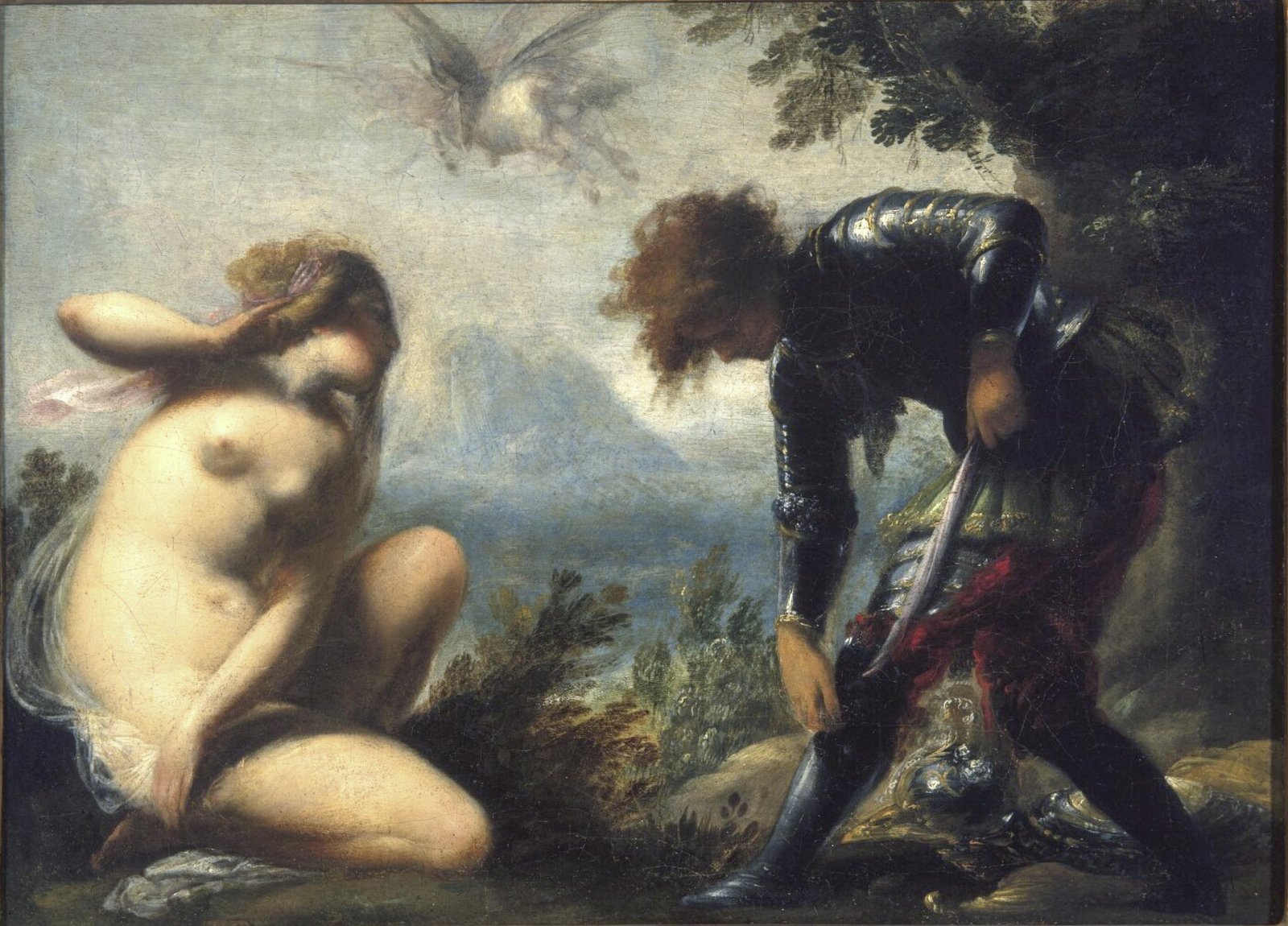
To find a chronological fixed point in the path we must wait for the Marriage of Sarah and Tobias from a private Florentine collection, a painting that we now know was executed between 1647 and 1648 for Lorenzo di Lorenzo Strozzi, probably the same one that Marco Lastri saw in the late eighteenth century in the Pitti house and chose and presented in his Etruria pittrice to discuss Cecco’s style. Preceded by a preparatory sketch, the canvas is characterized by a dramatic atmosphere, frayed brushstrokes and contrasting luminism, to be placed in relation to the coeval production of Felice Ficherelli, a painter whose nature was opposite to that of Our’s, but extraordinarily akin to him from this point in time until the end of his career.
A respectable place in the painting of the sixth decade belongs to the pair with Erminia among the Shepherds and Apollo and Marsyas from the Museo Civico in Pistoia, accompanied by a large group of preparatory drawings, a more unique than rare case for Cecco, attesting to the importance of the commission. The canvases, rich in passages of pure chromaticism such as Erminia’s crest, the sheep’s fleece and the satyr’s goat’s legs, show such relationships with the painting of Strozzi, the name under which they appeared at the Venetian exhibition of the seventeenth century held at Ca’ Pesaro in 1959, as to reveal how bewitched Cecco was by the Genoese capuchin.
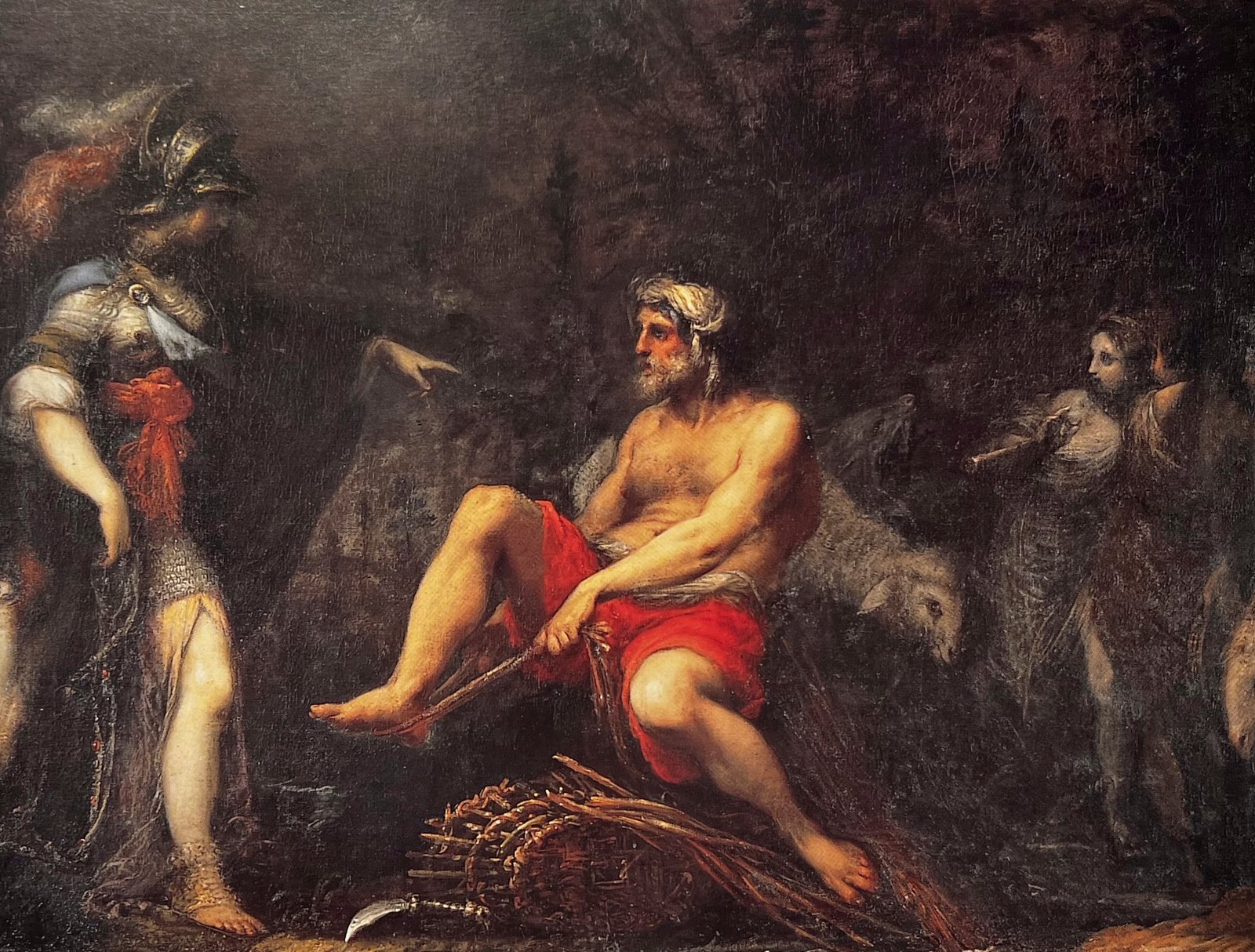
With the depiction of Erminia on the canvas now in Pistoia, and then, as we shall see later, with the painting dedicated to Armida now in the Uffizi, Cecco too, like so many of his Florentine colleagues, did not fail to depict famous episodes from Tasso’s Gerusalemme Liberata, a poem much beloved in Medici circles since it took on a particular value as a result of the wedding in 1589 between Ferdinando I and Christina of Lorraine, the latter presumed to be a descendant of Goffredo di Buglione, the hero of Tasso’s work and a model of a Christian condottiere, readily assimilated by Grand Ducal mythology.
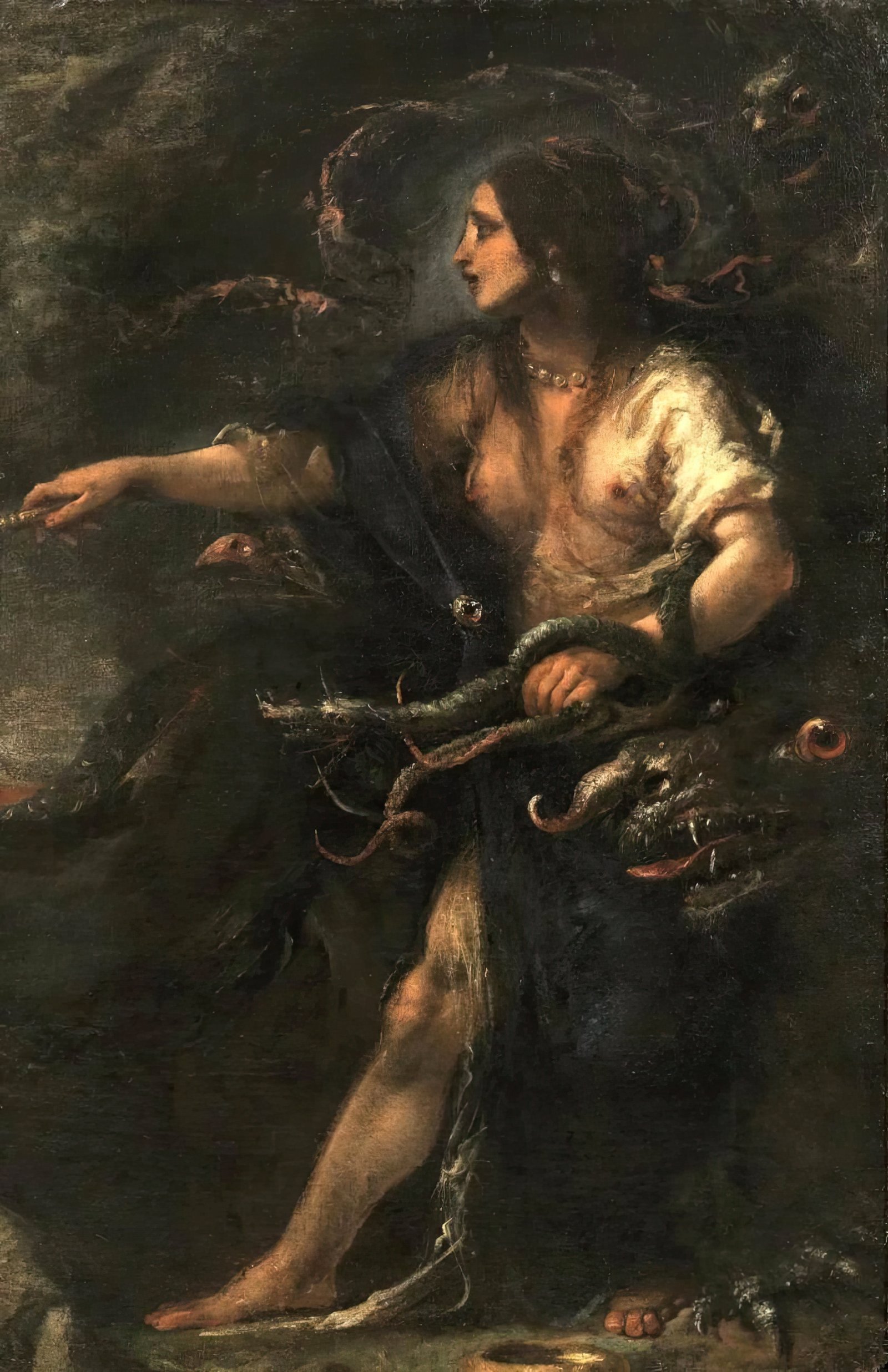
Unfortunately lost is the large fresco with the Fall of the Rebel Angels painted in 1653 for the counter façade of the church of Santi Michele e Gaetano in Florence, perhaps Cecco’s most celebrated work in the sources. Also lost to us are the two lunettes with the Presentation of Mary in the Temple on the portal of the church of Santa Maria Novella toward the Porta Vecchia, which was matched on the inside by the one with the coat of arms of the Manadori family supported by putti, a fragment of which survives, much ruined, today in the storerooms of the Villa di Castello. Making up for the loss of the fresco of Saints Michael and Gaetano remains the extraordinary and rich group of preparatory drawings. From Bilivert’s graphic style, Cecco derived the frenetic manner in sketching the images on the sheet, through a crushed and convulsive linearism, capable of capturing both the restless light vibrations of distant Leonardesque derivation and the abstract crystallization of splintered forms on the surface planes, drawn from the repertoire of Rosso Fiorentino and Giovanni Battista Naldini. The painter participates in the human drama of the precipitating, writhing angelic creatures, their faces convulsed with terror, as the pencil flows swiftly to define their features, their lean bodies.
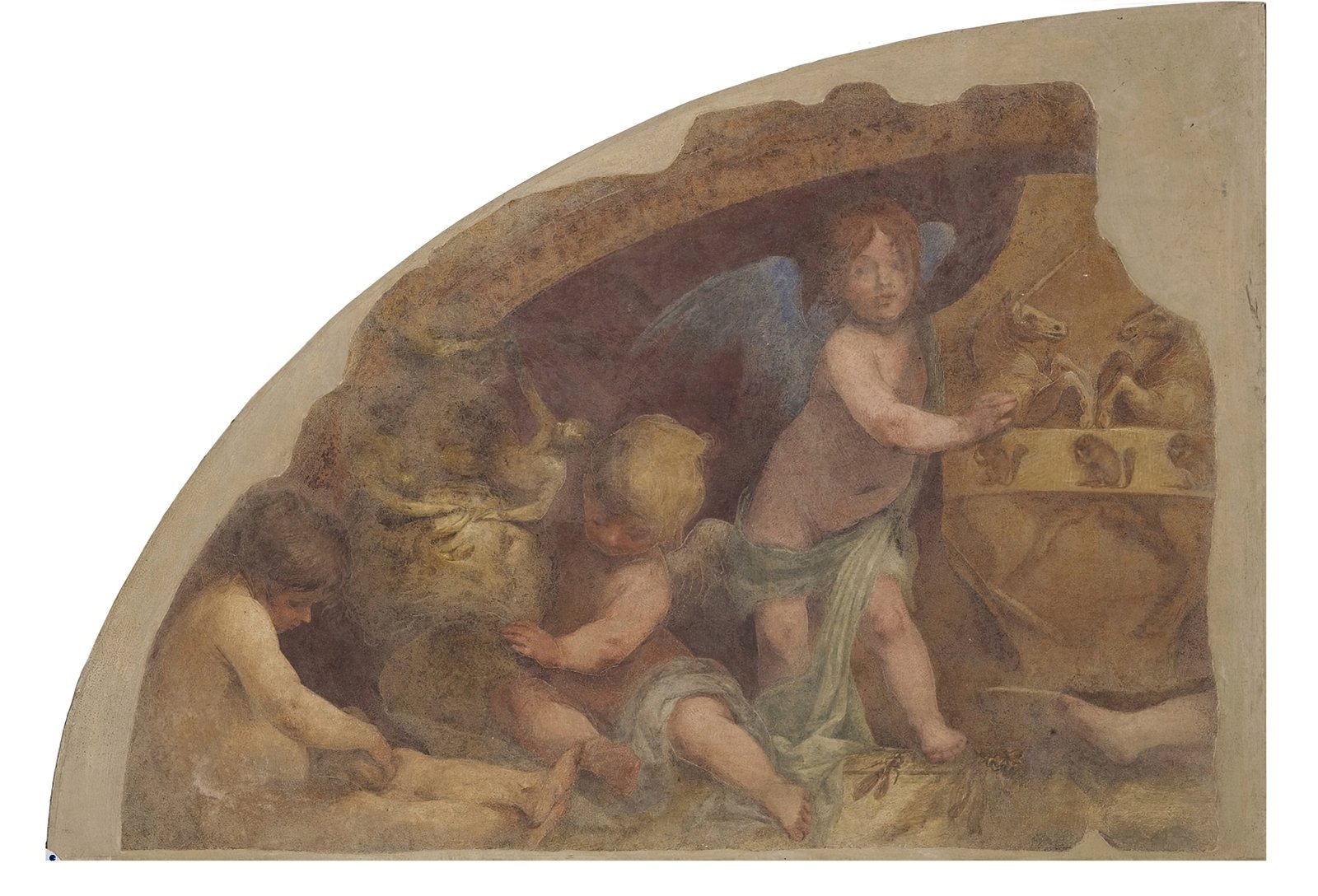
The Apollo and Daphne in the Pinacoteca Comunale di Ravenna, similar to the Armida in its fantastic verve and enveloping, fringed brushstroke, would also seem to date from the mid-’50s. In the tangle of kneaded limbs of color interpenetrated by light, the lesson of the last Titian is once again grasped. Here, too, what interests Cecco, as in all his other paintings, is the emotional rendering of the characters in action: Apollo is shown blinded by desire, fomented by Cupid hovering in the sky with his quiver drawn, while Daphne appears trembling with her face deformed by horror.

We are just a step away from the painter’s move to Innsbruck, which took place on June 1, 1660 in the company of his faithful pupil and friend Jacopo Benvenuti.
On November 26, 1656, Cecco received the title of “Master of the Natural” at the Florentine Academy of Drawing, following his colleague Simone Pignoni’s renunciation. At the time, Our was no longer considered among the city’s most important painters, as reflected in a lawsuit brought the previous year by sculptor Domenico Pieratti against Agnolo Galli. In the shortlist of names, indicated by at least three qualified witnesses, among the most significant artists in Florence, Cecco’s does not in fact appear. It was undoubtedly the loss of popularity and the lack of important commissions that prompted Montelatici to accept, under pressure from his loyal patron, Cardinal Leopoldo de’ Medici, the invitation of the latter’s sister, Anna de’ Medici, to move to Innsbruck.
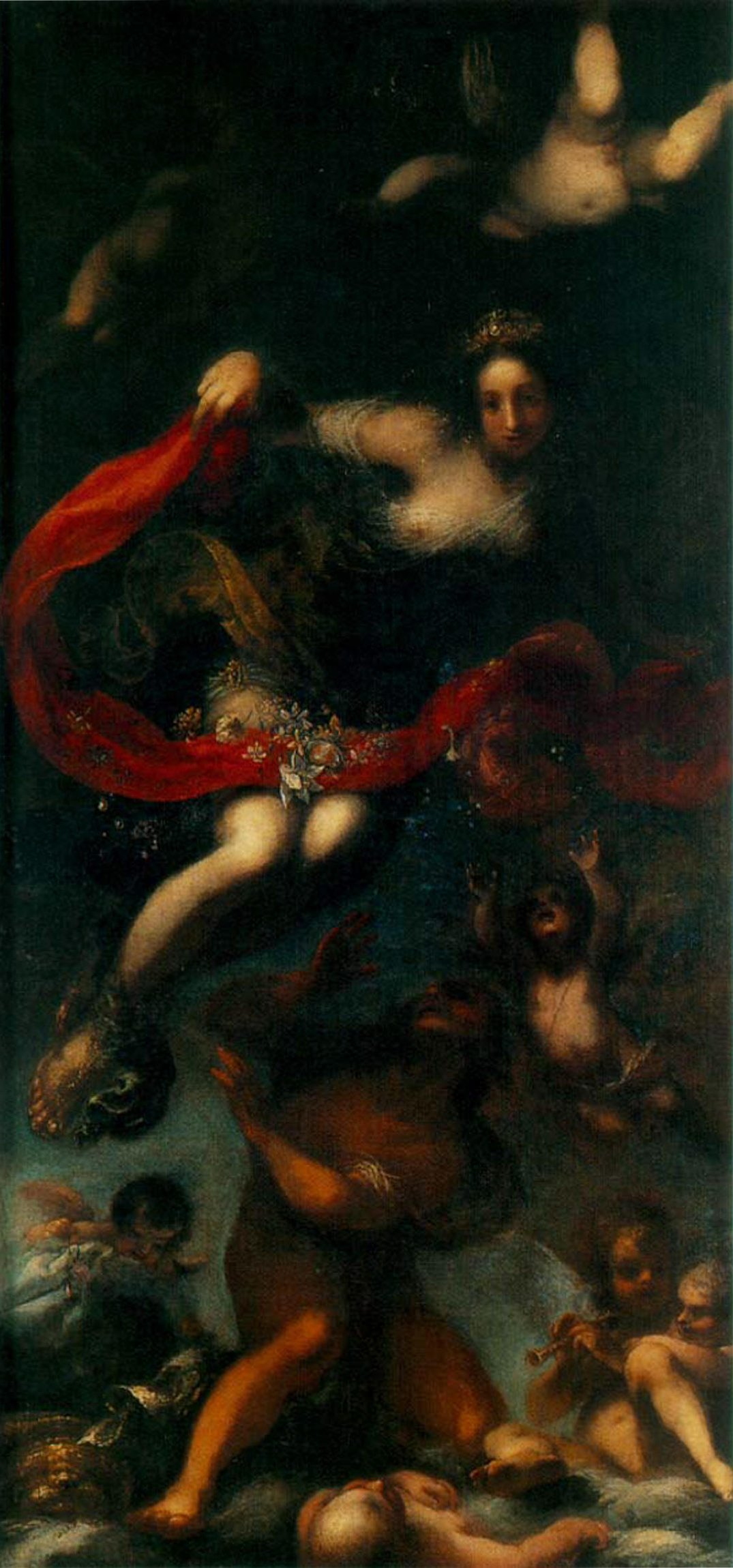
From this sojourn at the Tyrolean court only two paintings remain with certainty: the Aurora, now in the Kunsthistorisches Museum in Vienna, a subject dear to Cecco, previously depicted in the canvas owned by the Gallerie Fiorentine and now in storage at the Camera in Palazzo Montecitorio in Rome, and the portrait of Archduke Ferdinando Carlo of Tyrol on horseback at Ambras Castle in Innsbruck. The latter, begun by Justus Suttermans in 1656 and left unfinished, was completed by Our, who completed all areas of the large canvas except the face of the protagonist. The painting offers Cecco’s highly personal vision of the equestrian portrait, a genre that boasts an illustrious tradition dating back to the Renaissance. The entangled insertion of soldiers and horses from the battle in the background, rendered with rapid brushstrokes darting with light, says a lot about the painterly eagerness of the late Montelatici. The Our undoubtedly kept in mind not only the paintings of Salvator Rosa but also those of the French Jacques Courtois known as Borgognone, who was long active in Florence where he was a protégé of Prince Mattias de’ Medici. Whereas, however, in Borgognone the light does not dissolve the tangled and intricate groups of figures, arms and horses, in Cecco each element is as if undone, made almost phosphorescent by the light that enfolds it.
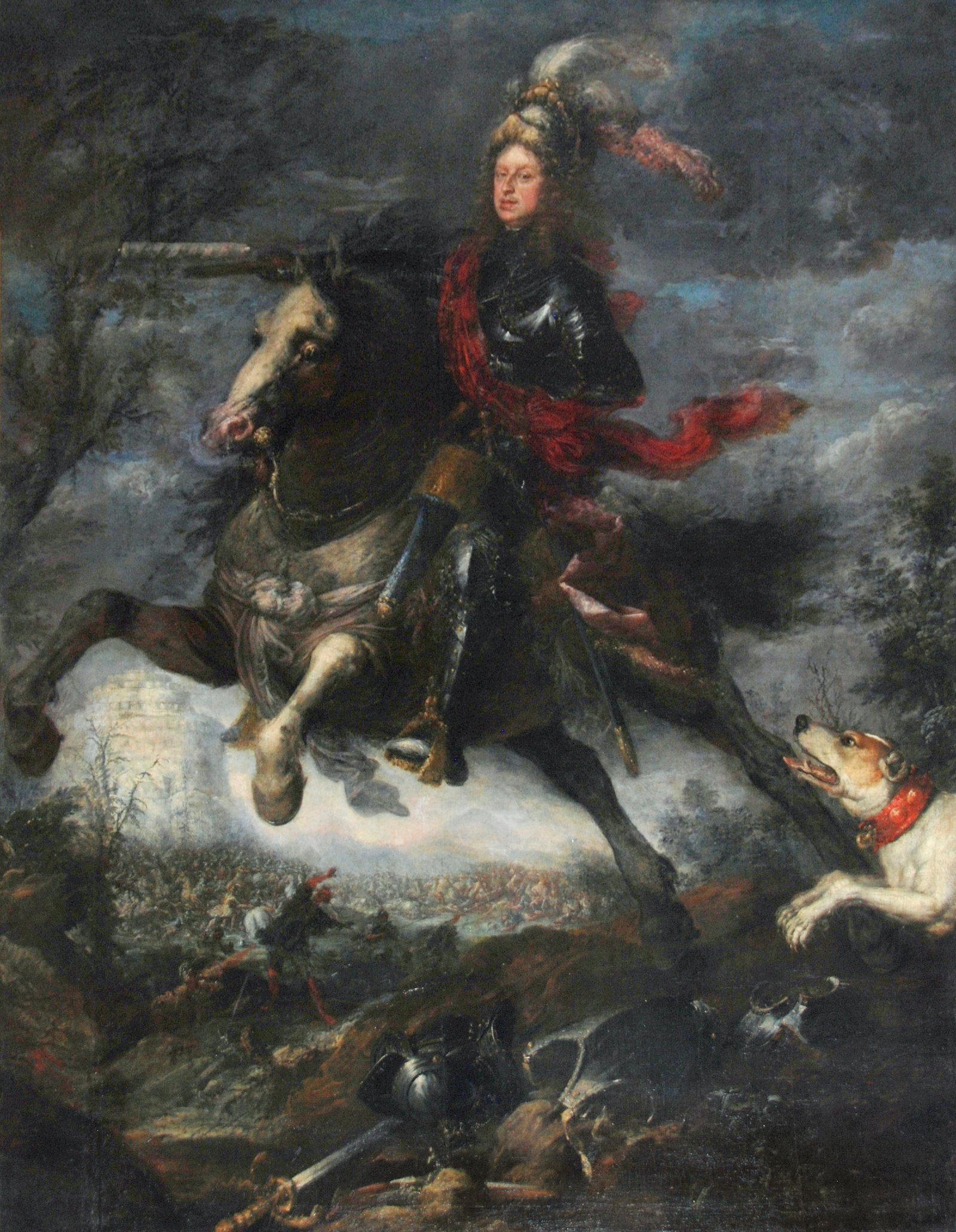
Cecco’s final paintings are dramatic and mysterious, feeding on dreams and, in their hallucinatory eccentricity, drawing the viewer into the scene so much that they would feel part of it. Death caught Cecco in Innsbruck in early 1661 at the age of only sixty, when he was at the height of his energies, open to recording new experiences and reworking them in a personal and original language.
Francesca Baldassarri is the leading expert on seventeenth and eighteenth-century Florentine painting, a field she began investigating under the guidance of Mina Gregori and the poet and art collector Piero Bigongiari. She curated the complete catalogue of Carlo Dolci’s paintings and the index of artists and artworks of 17th-century Florentine painting. She recently published the first monograph on Florentine artist Cecco Bravo (link).
September 26, 2024
